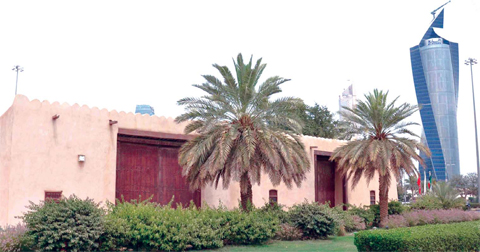 "Al Shaab" gate one of the third remaining fence gates
"Al Shaab" gate one of the third remaining fence gatesDo you know that a small fort (kut) was the nucleus of Kuwait and its history and that Kuwait derives its name from this famous structure? It was situated where the Amiricani Cultural Center stands today on Arabian Gulf Street close to the National Assembly. According to historical accounts, the date of construction of the fort was around 1669, when Barrak bin Ghurair held the reins of power as the first chief of the region’s powerful Bani Khaled tribe.
The years after 1700 saw a proliferation of clans due to immigration to this new ‘country’. In those years, Al Sabah, the current rulers of Kuwait, immigrated from Najd in central Arabia and settled in Kuwait. They took the reins of power in 1718. The main problem that affected Kuwait in that period was water shortages and lack of potable water, so the people imported water from the Shatt Al-Arab area of Iraq. The water was transported in tanks by the famous Kuwaiti al-boom dhows.
The main economic activity of Kuwait since its inception was pearl diving and maritime trade, such as palm and timber trade with both India and Iraq and other trades and professions that have been associated largely with maritime activity, such as shipbuilding. But the pearl industry was decimated by the global recession and by the appearance of cheap Japanese cultured pearls in 1934.
From the distance, Kuwait and its bay looked small, like some early watercolor landscape. The wind was clean and strong, made of pure air and saltwater. It hung in the tents heavy as a royal cloak and gave a luminous quality to the shadows inside.
The wall represented one of the historical monuments of Kuwait. You can describe it by saying it was a city with three walls, that inspired other cities to build fences. The wall was to protect Kuwait from attacks by aggressors. The walls were made of mud and surrounded the city from the land side. They contained many large gates that worked according to daily schedules. The doors opened in the morning and closed in the evening. Guards worked at these gates to organize the entry and departure of people and goods.
Freya Stark wrote about these guards: “They lounge in their seat or squat in the windowless den brewing coffee, keeping their eye on who goes in or out, and in their toothless way, uphold the rule of law. They wait for the approaching end of their days with that dignity which is the keynote of Arabia, made of poverty and leisure and of a complete unconsciousness of dress as an asset to respectability, or of physical comfort as an essential to happiness.”
Kuwait knows these three walls defined its history. They represented the defensive line for Kuwait against any possible attacks.
The first wall around Kuwait City was built in the era of Sheikh Abdullah bin Sabah II (1776-1814) in 1793. Its total length was 750 m.
The second wall of Kuwait was built in 1811. It took two months to build, with a total length of 2,300 m. This wall had five gates (darwazas) made of wood. Historical sources indicate that this fence was in place for about 70 years until it was destroyed by climatic factors.
The third wall of Kuwait was built in 1920 in the era of Sheikh Salem Al-Mubarak (1864-1921), the ninth ruler of Kuwait. With a total length of 6,400 m, work on this wall began in the holy month of Ramadan in the summer. It witnessed the dedication of the people of Kuwait, and many of them donated a lot of money, while some donated various construction tools. This wall had five gates - Darwaza Dasman, Darwaza Al-Shaab, Darwaza Al-Shamiya, Darwaza Al-Jahra and Darwaza Al-Meqsab. With the discovery of oil and the subsequent economic and urban development in various fields, the wall was demolished in 1957.
The fence has been linked in Kuwait’s memory with numerous stories and anecdotes - in springtime, when most Kuwaitis picnic in the desert, groups of women trail their black abayas, their faces hidden, under the gateway. Small donkeys with enormous ears trot in with lime and head out with water. Smugglers move about the village of huts which has grown since the customs law of neighboring Iraq made the risk worthwhile. And a sight most beautiful, no doubt seared in our unconscious memories from the very earliest days of tribal man: In the late afternoon, flocks of goats return with their goatherds, pouring like black velvet through the nail-studded door across the empty open space with the sunlit wall and its towers behind them, until they reach the appointed place where their owners (who pay three annas a month for this service) come to separate them and take them to their homes.
This open place within the walls is also used by boys with time on their hands to lure the common little blue and brown kite from the sky. A decoy is tied to a stone as they sit demurely in the dust, trying, like unhappily married Victorians, to look as if they like it. Nearby, traps are arranged - circular concave metal discs that close with a snap when the spring is released. A white caterpillar is tied by its waist (if a caterpillar’s figure comprises such a thing), that wriggles slowly round and round like a semaphore, succulently obvious from above.
The boys wait at distance and trap four or five birds daily. They then sell them to children who like to walk about with a bird at the end of a string in their hand. It seems all the missionary efforts by Kuwait over a period of many years hasn’t succeeded in eradicating this simple pleasure!
AbouAlella is a researcher in heritage for the Ministry of Information.
By Mahmoud Zakaria AbouAlella
 Hong Kong Bannar.jpg)








